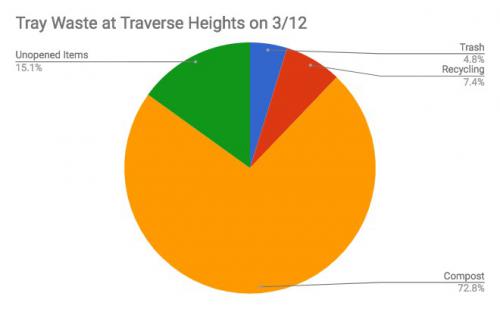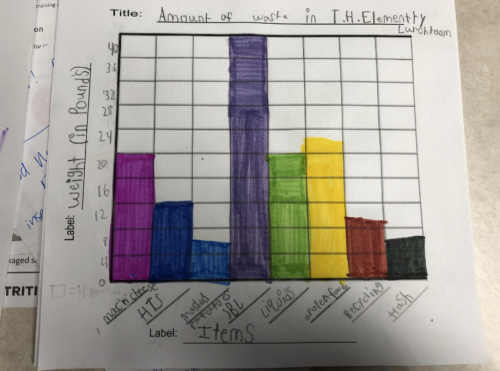Students learn how to improve nutrition and reduce food waste through classroom lesson
Students at Traverse Heights Elementary learned an important lesson about food waste and nutrition.
“No, no, no! Wait!” Phillip exclaimed, waving his hands in the air. Usually, teachers remind fifth-graders to do their best to control their impulse to blurt, but this fifth-grader’s reaction was an important teachable moment. Let’s set the scene.
Every student in the fifth grade class at Traverse Heights Elementary had received two bananas, except for the four who represented the one in five kids in America who do not have enough to eat. The sixteen students with bananas separated their pair and put the smaller into a collection bowl. Taylor Moore of Food Rescue of Northwest Michigan collected the bananas (rescued from a local grocery store) and asked where he could find the trash can. What the students did not yet know was that these bananas represented the forty percent of food that gets wasted in America.
Phillip made his exclamation as Taylor tipped the bowl toward the trashcan to illustrate how much food is wasted despite the fact that many folks are food insecure. He was one of the four students who did not get bananas. After Phillip explained his reaction, the class agreed that it did not make sense to throw away food when others did not have any.
A discussion about what individuals can do to reduce food waste followed this demonstration. Food can sometimes still be eaten even if it is not at peak freshness. For example, spotty and brown bananas can be made into banana bread or frozen for smoothies or banana “ice cream.” To illustrate that bananas can be eaten at many stages, students participated in a blind taste test of green, yellow and spotty bananas. Though they could discern banana ripeness fairly accurately, some students learned that the spottier bananas were actually the sweetest!
To learn about food waste in their own school cafeteria, students used measurements taken earlier in the week during a tray waste assessment to create visual representations of the data. During the assessment, volunteer representatives from several community partners collected approximately 135 pounds of waste from students' trays in the cafeteria. Only seven pounds of that was actually garbage. The team collected forty pounds of leftovers from the salad bar and twenty-one pounds of unopened food (fruit and milk). Students translated this data into bar graphs in order to share the results of the tray waste assessment with the school community.
A bar graph of tray waste assessment data by Ava, a fifth grader at Traverse Heights Elementary. (HTS = hot turkey sandwich, SBL = salad bar leftovers)
After making the bar graphs, the situation was clear to students: if so much food is wasted in the cafeteria, then students are receiving limited nutritional benefit from that food. This led to a conversation about what they might be able to do to encourage their peers to eat more of their food and throw less away. A fifth grader suggested making posters for the cafeteria to remind students that three components make a reimbursable meal, and that students are permitted to return to the salad bar as needed for more food. In addition, as a FoodCorps service member and a fellow nutrition educator I will facilitate the implementation of Smarter Lunchrooms in the school cafeteria. Smarter Lunchrooms is a tool that provides free or low-cost strategies to build a healthy lunchroom environment. At some point, the data from the initial tray waste assessment can be used to determine the impact of these strategies within this particular school community.

Another option for sharing data from tray waste assessment.
Students need to be well nourished and ready to learn, so efforts will focus on encouraging students to eat the food that they take on the lunch line because school food is most nutritious when it is eaten. Most importantly, this is more likely to succeed if strategies are student-driven and school-informed. Student engagement and classroom to cafeteria connections promote the staying power necessary to create a long-term shift in school communities.
To learn more about the tray waste assessment at Traverse Heights, check out this 9 &10 News segment. Explore how to conduct your own tray waste audit and how to reduce food waste at home. For more information on the Smarter Lunchrooms Movement visit their website. Learn more about how Michigan State University Extension supports and implements these efforts in local schools by visiting the Smarter Lunchrooms Movement program page.
Sarah Perez-Sanz is currently a FoodCorps Service Member with Michigan State University Extension Grand Traverse County, serving two elementary schools in Northwest Michigan.



 Print
Print Email
Email


